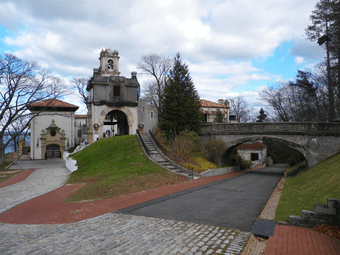Vanderbilt Museum facts for kids
|
William K. Vanderbilt Estate-Eagles Nest
|
|

Vanderbilt Mansion
|
|
| Location | 180 Little Neck Road, Centerport, New York 11721 |
|---|---|
| Area | 43 acres (17 ha) |
| Architect | Warren & Wetmore |
| Architectural style | Spanish Revival |
| MPS | Huntington Town MRA |
| NRHP reference No. | 85002545 (original) 100006094 (increase) |
Quick facts for kids Significant dates |
|
| Added to NRHP | September 26, 1985 |
| Boundary increase | February 2, 2021 |
The Vanderbilt Museum is a cool place to visit in Centerport, New York. It's on the North Shore of Long Island in Suffolk County, New York. The museum is named after William Vanderbilt II (1878–1944). It sits on his old home, a large 43-acre estate called Eagle's Nest.
Contents
History of Eagle's Nest
William K. Vanderbilt II was a famous person who loved to travel and collect things. When he passed away, his will said that his property should become a museum. He wanted his mansion and land to show off his amazing collections. These included items from the ocean, natural history, and different cultures. The museum officially opened in 1950.
Building the Mansion
Vanderbilt's estate was built in three main parts. The first part was a huge 24-room mansion. It was designed in a Spanish Revival style. The famous New York architecture firm Warren and Wetmore designed it. This same firm also helped design Grand Central Terminal in New York City. The building of the estate took many years, from 1910 to 1936.
Since the 1930s, the mansion has been home to a very old mummy. This mummy is believed to be a young woman. She was originally buried in a place called Deir el-Bahari. William Vanderbilt II bought her in 1931 from an antique shop in Cairo.
What You Can See at the Museum
The museum complex is run by Suffolk County. It includes the mansion, which is filled with original furniture and beautiful art. There's also a special marine museum. It has many ocean and nature items. You can see butterflies, birds, shells, mammals, and fish. The estate also has a curator's cottage, a seaplane hangar, and a boathouse. You can explore lovely gardens too. The museum also displays objects from different cultures. These include old firearms, swords, and ship models. There are also items from Europe, Asia, and Africa. The museum was added to the National Register of Historic Places on September 26, 1985.
Living History Tours
Sometimes, the Vanderbilt Museum offers special "living history tours." During these tours, staff members dress up in costumes. They act out scenes from the past, showing what life was like for wealthy people on the Gold Coast. They use information from Vanderbilt's own journals. They also use old records about other people who lived and worked there. It's like stepping back in time!
The Planetarium
The planetarium at the Vanderbilt Museum first opened in 1971. It was a very important building for its time. Mark Levine, who is the director of the planetarium, said it was a "forerunner" for many other planetariums built later.
Modern Upgrades
In 2013, the planetarium had a big makeover. They replaced the roof, carpets, and seats. The gift shop, lobby, and ticket office were also improved. The planetarium now has a special Konica Minolta GeminiStar III projector. It also has a full dome display and amazing surround-sound technology. This makes watching shows there a really cool experience.
Public Observatory
The planetarium also has an observatory. This is a place where you can look at stars and planets. It's open to the public on Friday nights. The observatory has a powerful 16-inch Meade LX200R telescope. It has a special roof that rolls off, letting you see the night sky clearly.
Images for kids






